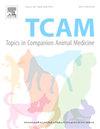Mammary neoplasms in male dogs: A 24-year descriptive study
IF 1.3
3区 农林科学
Q2 VETERINARY SCIENCES
引用次数: 0
Abstract
Mammary neoplasms in male dogs are as rare as in humans, accounting for <1% of all tumors. In a descriptive review of cases diagnosed between 2000 and June 2024, 2,172 mammary neoplasms were identified, of which only four (0.18%) occurred in male dogs. The patients ranged in age from 8 to 11 years, with a mean age of 9.7 years. Histopathological analysis revealed that 75% (3/4) of the cases were malignant, while 25% (1/4) were benign. Among the malignant cases, only one patient exhibited regional metastases. Two patients had concurrent testicular neoplasia, both diagnosed as Leydig cell tumors. Malignant histological subtypes included carcinosarcoma, tubular carcinoma, and carcinoma within a mixed tumor. The only benign tumor identified was a benign mixed tumor. All malignant neoplasms exhibited high expression of hormone receptors, highlighting their potential role in tumor development. Additionally, cyclooxygenase-2 (COX-2) expression, a potential therapeutic target and prognostic factor, was observed. Early diagnosis is crucial for improving prognosis; however, due to the rarity of this condition, diagnosis is often delayed. These findings emphasize the occurrence of these neoplasms in male dogs, and report on complementary techniques to improve therapeutic strategies.
雄性犬乳腺肿瘤:一项为期24年的描述性研究。
雄性狗的乳腺肿瘤和人类一样罕见,占所有肿瘤的不到1%。在对2000年至2024年6月诊断病例的描述性回顾中,发现了2172例乳腺肿瘤,其中只有4例(0.18%)发生在雄性狗身上。患者年龄8 ~ 11岁,平均9.7岁。组织病理学分析显示75%(3/4)的病例为恶性,25%(1/4)为良性。恶性病例中仅有1例出现局部转移。两例患者并发睾丸肿瘤,均诊断为间质细胞瘤。恶性组织学亚型包括癌肉瘤、小管癌和混合性肿瘤内癌。唯一确定的良性肿瘤是良性混合性肿瘤。所有恶性肿瘤均表现出激素受体的高表达,突出了其在肿瘤发展中的潜在作用。此外,还观察了环氧化酶-2 (COX-2)的表达,这是一个潜在的治疗靶点和预后因素。早期诊断对改善预后至关重要;然而,由于这种情况的罕见性,诊断往往被延迟。这些发现强调了这些肿瘤在雄性犬中的发生,并报告了改进治疗策略的补充技术。
本文章由计算机程序翻译,如有差异,请以英文原文为准。
求助全文
约1分钟内获得全文
求助全文
来源期刊

Topics in companion animal medicine
农林科学-兽医学
CiteScore
2.30
自引率
0.00%
发文量
60
审稿时长
88 days
期刊介绍:
Published quarterly, Topics in Companion Animal Medicine is a peer-reviewed veterinary scientific journal dedicated to providing practitioners with the most recent advances in companion animal medicine. The journal publishes high quality original clinical research focusing on important topics in companion animal medicine.
 求助内容:
求助内容: 应助结果提醒方式:
应助结果提醒方式:


